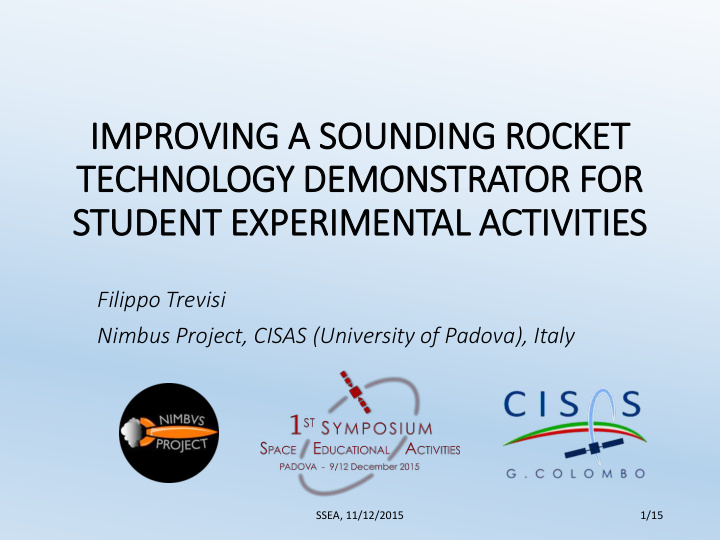



IM IMPROVING A SOUNDING ROCKET TECHNOLOGY DEMONSTRATOR FOR STUDENT EXPERIMENTAL ACT CTIV IVITIES Filippo Trevisi Nimbus Project, CISAS (University of Padova), Italy SSEA, 11/12/2015 1/15
Nimbus Project Founded in 2012 by three students • Now made of young engineers and students (all from • University of Padova) Meetings are on every Saturday and during the week • SSEA, 11/12/2015 2/15
SSEA, 11/12/2015 3/15
The Sagitta system Sagitta is designed, built and tested with: Modular main frame • Composite materials • COTS electronics • Reusability approach • Dry mass: 3-3.5 kg Propellant mass: 200-450 g Total Impulse: 200-560 Ns Max altitude: 1000 m SSEA, 11/12/2015 4/15
1) Propulsion system Sagitta’s solid rocket motor Simple and cost-effective • Reliable and repeatable • The propellant used is stable • Rocket motor Test bench SSEA, 11/12/2015 5/15
2) Fuselage and main frame Fuselage Modular main frame Made of GFRP through a • Composed of beams • VA-RTM process made of commercial CFRP and decks in GFRP Repeatable mechanical • properties Tested load: • Compression 1200 N, Cost-effective materials • Traction 1700 N Good finishing • FEA validation with • bending load SSEA, 11/12/2015 6/15
3) Electronics Open-source, COTS platform ( Arduino ) has been chosen to control the flight segment Easy to interface • Low-cost, mass, volume and power consumption • Performaces tailored to the needs • Ground segment is composed of a PC with a custom GUI • and HGA SSEA, 11/12/2015 7/15
4) Re-entry system & 5) Payloads The re-entry system is composed by: A standard round parachute • A NON-pyrotechnic system for • parachute ejection The payloads are: An atmospheric measurement unit • with temperature, pressure and humidity sensors in the nose cone IMU in the internal bay • SSEA, 11/12/2015 8/15
System improvements ALREADY DONE IN DEVELOPMENT Software : safer, faster • Motor ignition system : • saving 7% in mass and Compacted electronics : • 3% in volume less volume and mass Payload bay : third party • Fuselage : 14% mass • payload saved More free volume Payload bay for students’ experiments SSEA, 11/12/2015 9/15
High power motor configuration Max thrust: 650 N • Propellant mass:450 g • Total Impulse: 560 Ns • SSEA, 11/12/2015 10/15
Second flight Max altitude: 504 m • Mass at launch: 3.8 kg • Propellant mass: 360 g • Payload mass: 200 g • Total Impulse: 400 Ns • Parachute deployment Propulsive phase SSEA, 11/12/2015 12/15
Payload results Data from IMU housed in Acceleration caused by the internal bay thrust Max acceleration: 13.5 g • Min acceleration: -0.46 g • Mean angular vel: 300°/s Motor Cut-Off • Take Off SSEA, 11/12/2015 13/15
Conclusions Students , taking part in the project, have improved their • skills working on Sagitta. Two graduation theses have been produced, with the • collaboration of some university professors. Sagitta can be used for carrying students’ payloads or used • as a platform for other educational activities . A technology demonstrator has been developed to show the • concept of a reusable, cost-effective sounding rocket . Two successful launches proved the effectiveness of the • technology demonstrator and showcased its performance. SSEA, 11/12/2015 14/15
QUESTIONS? Filippo Trevisi nimbusproject012@gmail.com Thanks to Prof. Stefano Debei, Eng. Carlo Bettanini, Eng. Mirco Zaccariotto (CISAS, University of Padua), Fulvio Stel and Alberto Gobbi, Eng. Federico Rodighiero, Eng. Andrea Franchini. SSEA, 11/12/2015 15/15
Recommend
More recommend